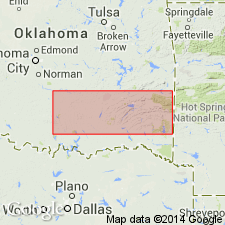
- Usage in publication:
-
- Prairie Mountain formation
- Modifications:
-
- Named
- Dominant lithology:
-
- Sandstone
- Shale
- AAPG geologic province:
-
- Ouachita folded belt
Summary:
Named as a formation (1 of 4) of Jackfork group (raised in rank) of Pushmataha series (new) of the Bendian period; name taken from Prairie Mountain. Type locality designated in Prairie Mountain, in the center of sec 25, T1S, R12E, Atoka Co, OK in the Ouachita tectonic belt province. Found in southeast OK in the Ouachita Mountains. Consists of a very thin (1 to 2 ft thick) but widespread, dark-gray to gray, siliceous shale which marks the base of this formation in most parts of Ouachita Mountains; followed by alternating mostly massive, fine to coarse, subangular sandstones and intercalated shales. The basal siliceous shale weathers to bluish gray and gray color; very commonly it weathers to tan, yellowish, or maroon mottling. Succeeding massive sandstones form very prominent ridges in area from Round Prairie to OK state line. About 450 ft above base is a widespread maroon and green shale [thickness not stated] named Prairie Hollow member. Is 4,300 ft thick in Tuskahoma syncline; is 1,350 ft thick in Prairie Mountain. Has rectangular lined weathered pattern. Overlies Wildhorse Mountain formation (new) and underlies Markham Mill formation (new), both of Jackfork group of Pushmataha series of Bendian period. Contains plant fossils--SIGILLARIA, CALAMITES, LEPIDODENDRON. Correlation chart. Geologic map. Of Carboniferous age.
Source: GNU records (USGS DDS-6; Denver GNULEX).
For more information, please contact Nancy Stamm, Geologic Names Committee Secretary.
Asterisk (*) indicates published by U.S. Geological Survey authors.
"No current usage" (†) implies that a name has been abandoned or has fallen into disuse. Former usage and, if known, replacement name given in parentheses ( ).
Slash (/) indicates name conflicts with nomenclatural guidelines (CSN, 1933; ACSN, 1961, 1970; NACSN, 1983, 2005, 2021). May be explained within brackets ([ ]).

